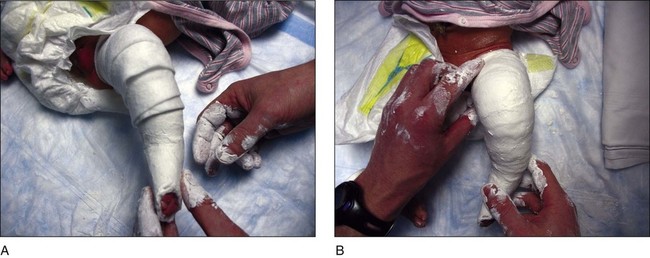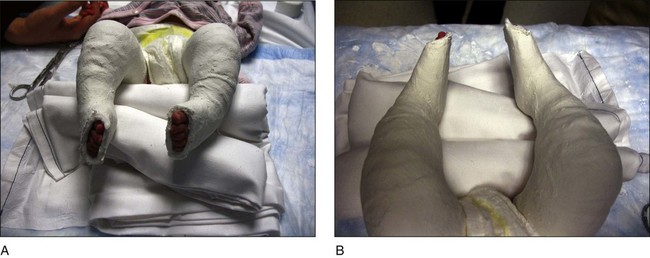• The forefoot is placed in supination in line with the hindfoot, and the first ray is dorsiflexed. • Cast padding is applied to cover the toes distally (Fig. 3A). A plaster cast is applied using a 2-inch plaster roll (Fig. 3B). Cast should be cut distally so that all five toes are visible (Fig. 3C). • This will correct the cavus deformity. • A short-leg plaster cast is placed first, allowed to dry, and then extended up the thigh to create a long-leg cast. This technique is recommended for all subsequent casts. • Figure 6 shows the first cast for a patient with bilateral clubfoot deformity from below (Fig. 6A) and from above (Fig. 6B).
Ponseti Method for Idiopathic Clubfoot Deformity
Indications
 Nonoperative management is indicated in all patients with an idiopathic clubfoot.
Nonoperative management is indicated in all patients with an idiopathic clubfoot.
 Treatment is best initiated shortly after birth; however, the Ponseti technique has been shown to be successful in older infants and children. The upper age limit of this technique has not been defined.
Treatment is best initiated shortly after birth; however, the Ponseti technique has been shown to be successful in older infants and children. The upper age limit of this technique has not been defined.
 The goal of treatment is a functional, plantigrade foot that is flexible, pain free, and without need for modified shoewear.
The goal of treatment is a functional, plantigrade foot that is flexible, pain free, and without need for modified shoewear.
Examination/Imaging
 Examination of the foot will demonstrate four components to the deformity:
Examination of the foot will demonstrate four components to the deformity:
 Figure 1 shows a child with bilateral clubfoot deformity from the dorsal (Fig. 1A) and plantar (Fig. 1B) views.
Figure 1 shows a child with bilateral clubfoot deformity from the dorsal (Fig. 1A) and plantar (Fig. 1B) views.
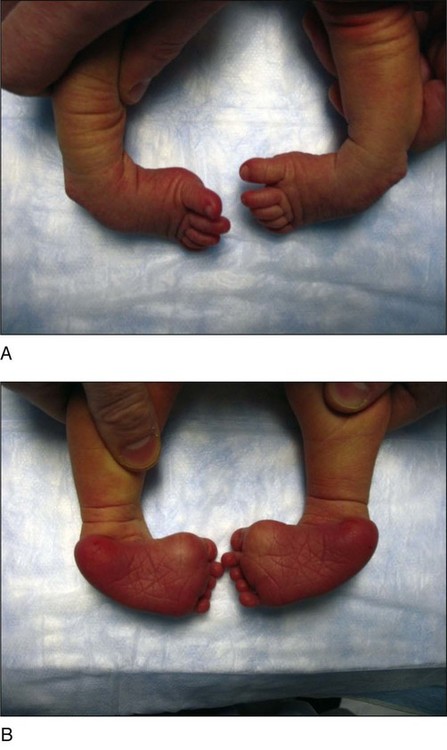
 The flexibility of the deformity is assessed.
The flexibility of the deformity is assessed.
 In the case of a unilateral clubfoot, the affected foot and calf are typically smaller than the uninvolved side.
In the case of a unilateral clubfoot, the affected foot and calf are typically smaller than the uninvolved side.
 Deep skin creases are often noted posteriorly and medially.
Deep skin creases are often noted posteriorly and medially.
 The flexibility of other joints (hips, knees and upper extremities) must be examined, looking for neurologic and spinal pathology that may be associated with other conditions such as arthrogryposis and myelomeningocele.
The flexibility of other joints (hips, knees and upper extremities) must be examined, looking for neurologic and spinal pathology that may be associated with other conditions such as arthrogryposis and myelomeningocele.
 The physician should examine for active movement of the foot and toes to assess for the presence of a neurologic deficit, suggesting a neuropathic clubfoot.
The physician should examine for active movement of the foot and toes to assess for the presence of a neurologic deficit, suggesting a neuropathic clubfoot.
 The remainder of the lower extremity is assessed for deformities and limb-length discrepancies, which may be indicative of a limb reduction disorder, such as fibular hemimelia, tibial hemimelia, or a bowing deformity.
The remainder of the lower extremity is assessed for deformities and limb-length discrepancies, which may be indicative of a limb reduction disorder, such as fibular hemimelia, tibial hemimelia, or a bowing deformity.
 There is little role for imaging in the diagnosis of a clubfoot deformity.
There is little role for imaging in the diagnosis of a clubfoot deformity.
Anatomy
 The navicular is subluxed medially and plantar to the head of the talus.
The navicular is subluxed medially and plantar to the head of the talus.
 There is decreased distance between the medial malleolous and the navicular, which can be detected by palpation on physical examination.
There is decreased distance between the medial malleolous and the navicular, which can be detected by palpation on physical examination.
 The talar head is palpable laterally just distal and medial to the lateral malleolous.
The talar head is palpable laterally just distal and medial to the lateral malleolous.
 The first ray is plantar flexed.
The first ray is plantar flexed.
 The forefoot is supinated relative to the floor, but pronated relative to the calcaneus, which is typically in more varus than the forefoot.
The forefoot is supinated relative to the floor, but pronated relative to the calcaneus, which is typically in more varus than the forefoot.
Procedure
Step 1
 Manipulations must always be gentle and never painful.
Manipulations must always be gentle and never painful.
 Approximately 1 minute is spent manipulating the foot.
Approximately 1 minute is spent manipulating the foot.
 Five or six manipulations and long-leg casts are typically needed. They are performed at 5- to 7-day intervals.
Five or six manipulations and long-leg casts are typically needed. They are performed at 5- to 7-day intervals.
 Figure 2 demonstrates the first manipulation in an anteroposterior (AP) (Fig. 2A) and lateral (Fig. 2B) view. The forefoot is supinated in line with the hindfoot, and the first ray is dorsiflexed.
Figure 2 demonstrates the first manipulation in an anteroposterior (AP) (Fig. 2A) and lateral (Fig. 2B) view. The forefoot is supinated in line with the hindfoot, and the first ray is dorsiflexed.
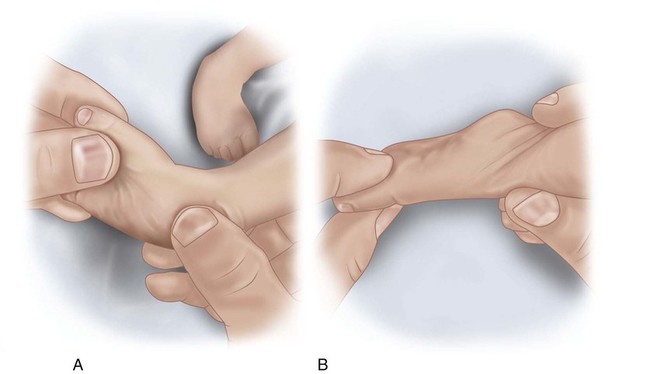
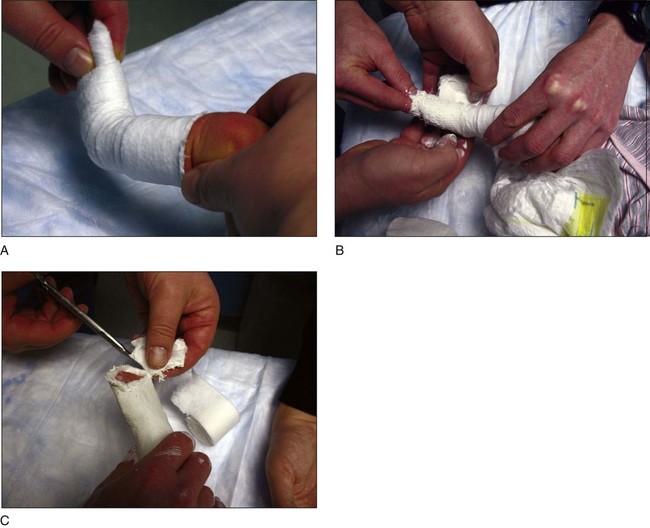
 Correct positioning of the foot is maintained while the short-leg cast is allowed to dry (Fig. 4).
Correct positioning of the foot is maintained while the short-leg cast is allowed to dry (Fig. 4).

 One the short-leg plaster cast has hardened, the cast is extended up the thigh. Cast padding is applied first (Fig. 5A). Plaster is applied up to the proximal thigh (Fig. 5B).
One the short-leg plaster cast has hardened, the cast is extended up the thigh. Cast padding is applied first (Fig. 5A). Plaster is applied up to the proximal thigh (Fig. 5B).
